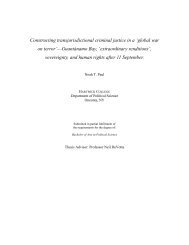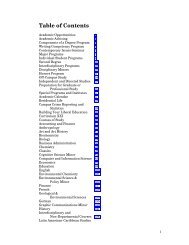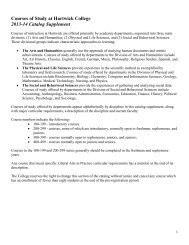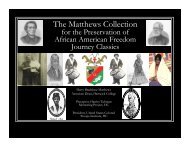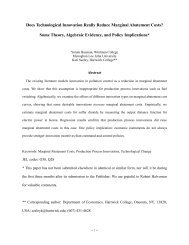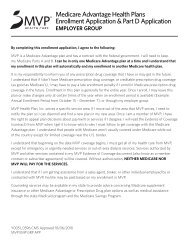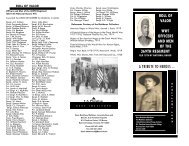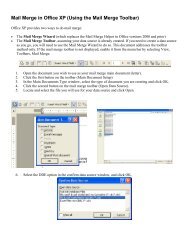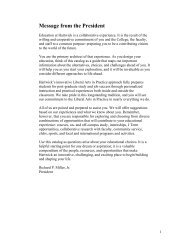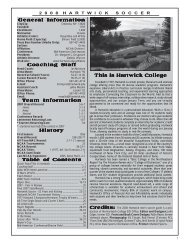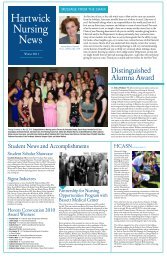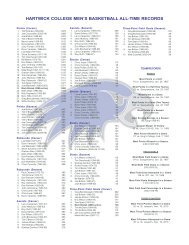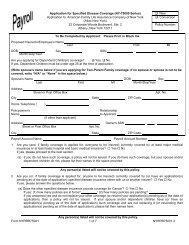USCTI Newsletter: Winter 2013 - Hartwick College
USCTI Newsletter: Winter 2013 - Hartwick College
USCTI Newsletter: Winter 2013 - Hartwick College
You also want an ePaper? Increase the reach of your titles
YUMPU automatically turns print PDFs into web optimized ePapers that Google loves.
<strong>Newsletter</strong><br />
<strong>Hartwick</strong> <strong>College</strong>, Oneonta, NY 13820<br />
Vol. 14 No. 2, December 2012<br />
USCT Civil War<br />
Digest<br />
ISSN: 1947-7384<br />
United States Colored Troops Institute for Local History and Family Research<br />
USCT Institute & ASFD Officers<br />
Harry Bradshaw Matthews, President,<br />
Senior Fellow, Oneonta, NY<br />
Darlene Colón, Vice President,<br />
Senior Fellow, Lancaster, PA<br />
Pamela L. Matthews, Secretary,<br />
Oneonta, NY<br />
<strong>USCTI</strong> Senior Fellows, Emeritus<br />
David A. Anderson, Rochester, NY<br />
Agnes Kane Callum, Baltimore, MD<br />
John R. Gourdin, Florence, SC<br />
Hugh MacDougall, Cooperstown, NY<br />
ASFD Fellows & Senior Fellows<br />
Roland Barksdale-Hall, Sharon, PA<br />
Cherry R. Baylor, Hempstead, NY<br />
Charles L. Blockson, Norristown, PA<br />
Agnes Kane Callum, Baltimore, MD<br />
Ruth E. Hodge, Carlisle, PA<br />
Gerald R. Hunter Sr., Arcadia, CA<br />
Sylvia Cooke Martin, Columbia, MD<br />
ZSun-nee K. Matema, Baltimore, MD<br />
D. Gail Saunders, Nassau, Bahamas<br />
Madeline O. Scott, Amherst, NY<br />
Executive Director and Editor<br />
Harry Bradshaw Matthews<br />
USCT Civil War Digest<br />
This newsletter is published with<br />
editing and graphics support of the Office<br />
of Communications at <strong>Hartwick</strong> <strong>College</strong>.<br />
This publication is produced twice a year,<br />
spring and fall, for the membership of<br />
the USCT Institute and for other select<br />
distribution.<br />
Send your comments to:<br />
Harry Bradshaw Matthews<br />
Associate Dean/USCT Institute<br />
U.S. Pluralism Center<br />
Bresee Hall<br />
<strong>Hartwick</strong> <strong>College</strong><br />
Oneonta, New York 13820<br />
matthewsh@hartwick.edu<br />
607-431-4428<br />
Harriet Tubman and Abraham Lincoln:<br />
Agents for Freedom and Equality<br />
As the <strong>2013</strong> African American History Month commemorations overlap the one hundredth<br />
anniversary of Harriet Tubman’s date of death, let us be mindful that her heroics were not for<br />
personal gain, but to confront unjust American laws that frowned upon the free legal status of<br />
black people in America, with the black family unit targeted for disrespect.<br />
Harry Bradshaw Matthews, <strong>USCTI</strong> Founding<br />
President and Carolyn Evans, Harriet Tubman re-enactor<br />
Tubman took her experience from the abusive<br />
system of bondage and used it to justify her<br />
reckoning that enslaved persons had the Godgiven<br />
right to freedom and the protection of<br />
their families. Tubman’s escape from slavery in<br />
1849 provided real evidence of what enslaved<br />
persons in America had to do in order to gain<br />
freedom. She was one of approximately 100,000<br />
runaway slaves between 1810-1850, yet received<br />
distinction because she risked her life during at<br />
least 17 escapades back into slave states to lead<br />
her family members, as well as others, to safety in<br />
the North. Her adventures were real and symbolic,<br />
since the vast majority of the 4.5 million black<br />
people in America during 1860 were enslaved,<br />
with only 500,000 with a semi-freedom status.<br />
Contrary to popular belief, more free black men<br />
and women resided within the Southern states in<br />
1860 than in the North.<br />
Tubman’s personal journey intersected with that<br />
of President Abraham Lincoln’s. The President<br />
felt driven to preserve the Union at all costs, even<br />
if it meant allowing for the continuation of slavery.<br />
He later changed<br />
his opinion after<br />
finally realizing<br />
that slavery was<br />
the real cause<br />
of the war.<br />
Consequently,<br />
the President<br />
prepared himself<br />
to take positive<br />
action supportive<br />
of the enslaved<br />
Americans,<br />
who collectively<br />
became known<br />
as Freedmen.<br />
Source: A Lost Hero, Elizabeth Stuart<br />
Phelps Ward and Herbert D. Ward,<br />
illustrated by Frank T. Merrill, 1891.<br />
Courtesy: The Matthews Collection<br />
Lincoln, however,<br />
did not believe<br />
in the equality<br />
between blacks<br />
and whites. He<br />
struggled with the idea that the two races would<br />
never be able to live peaceful lives together within<br />
this society. Tubman and Lincoln crossed paths<br />
Continued on Page 2
2 DECEMBER 2012 USCT Civil War Digest<br />
Tubman/Lincoln<br />
Continued from Page 1<br />
during the Civil War, when the epic battles, Lincoln’s Emancipation<br />
Proclamation, and the Thirteenth Amendment finally brought about<br />
the conclusion of legalized bondage in the United States. Today, the<br />
movie Lincoln shares an interpretation of the president’s dilemma from<br />
one perspective, while Tubman’s story is yet to be portrayed from the<br />
perspective of those who suffered the most.<br />
The great day of the nation’s judgment has come, and who shall be able to stand?<br />
Even we, whose ancestors have suffered the afflictions which are inseparable from a<br />
condition of slavery, for the period of two centuries and a half, now pity our land and<br />
weep with those who weep.<br />
The proceeding is but one line in a speech that revealed scholarship,<br />
religious faith, and purpose, which was followed by a challenge:<br />
Favored men, and honored of God as his instruments, speedily finish the work which<br />
he has given you to do. Emancipate, enfranchise, educate, and give the blessings of the<br />
gospel to every American citizen.<br />
Source: The Story of My Life, Mary A. Livermore, 1898. Courtesy: The Matthews Collection<br />
The movie, Lincoln, focuses upon important events during the final four<br />
months of the president’s life that ended with his assassination in April<br />
1865. It is unfortunate that the story line missed two great opportunities<br />
that linked the efforts of both Tubman and Lincoln. First, in mid-February,<br />
1865, the Reverend Henry Highland Garnet became the first black<br />
man allowed to speak in the United States House of Representatives; his<br />
primary topic was slavery. Only days earlier the House of Representatives<br />
had passed by the required two-thirds majority the amendment to end<br />
slavery in the United States. Garnet was invited by Republicans to deliver<br />
an address commemorating the historic vote. The House chamber, during<br />
the recess, was filled, with black persons comprising about a third of the<br />
audience, according to records at the Office of the Clerk of the U.S. House<br />
of Representatives.<br />
Rev. Henry Highland Garnet<br />
Source: The Negro in Our History,<br />
Carter G. Woodson, 1922.<br />
Courtesy: The Matthews Collection<br />
As a former slave who had progressed<br />
to the level of acquiring a classical<br />
education at the Oneida Institute in<br />
Whitesboro, New York, Rev. Garnet<br />
was one of the “classical fifteen” scholars<br />
who had advanced the definition of<br />
the Colored American identity. While<br />
attending the 1843 Buffalo Convention<br />
of Colored men in New York, the<br />
27-year-old Garnet advocated for his 4<br />
million enslaved brethren and sisters to<br />
revolt. Twenty-two years later, he stood<br />
in the Capitol, better prepared than<br />
most to voice the God-given right of the<br />
racially oppressed. He stated:<br />
Lincoln and the Broken-Shackle Army. Source: Camp-Fires of the Afro-American, James M.<br />
Guthrie. Illustrator: J.E. Taylor, 1892. Courtesy: The Matthews Collection<br />
Certainly, Garnet’s challenge was addressed to President Lincoln and other<br />
leaders. Lincoln, however, had another idea in mind. Only weeks before<br />
his assassination, he had engaged General Benjamin Butler in a discussion<br />
regarding the removal of all the surviving black soldiers and their families<br />
from the United States for fear of an impending race war. He knew that with<br />
more than 150,000 black men surviving their role as soldiers they would<br />
never allow themselves and their families to return to the state of abuse that<br />
most had left upon their enlistment into the Union Army.<br />
Source: Shuttered Windows,<br />
Florence Cannell Means, 1938.<br />
Courtesy: The Matthews Collection<br />
The discussions were limited between<br />
Lincoln, Butler, and Secretary James<br />
Seward. A final decision by the president<br />
was cut short by an assassin’s bullet.<br />
Consequently, he did not live long<br />
enough to witness the ratification of the<br />
Thirteenth Amendment by the states<br />
on December 6, 1865. But, history has<br />
placed Lincoln in eminence for ending<br />
slavery in this country and setting the<br />
Freedmen on a new path.<br />
Collectively, the Freedmen advanced<br />
themselves during subsequent<br />
decades and generations, even as they<br />
were confronted by Jim Crow laws,<br />
segregation, and just pure racism.
USCT Civil War Digest DECEMBER 2012 3<br />
Historic Milestones of <strong>2013</strong><br />
The year <strong>2013</strong> provides the United States Colored Troops Institute at <strong>Hartwick</strong> <strong>College</strong> with several commemorations. First, the<br />
<strong>USCTI</strong> celebrates the 15th anniversary of its founding. While its primary focus continues to be upon the 200,000 black soldiers<br />
of the Civil War and their 7,000 white officers, the <strong>USCTI</strong> has expanded its scope to include attention to black soldiers from the<br />
Revolutionary War through World War II. In addition, the <strong>USCTI</strong> has become a recognized resource for the study of the anti-slavery<br />
movement, signified by the organization’s designation by the National Park Service as a resource facility of the National Underground<br />
Railroad Network to Freedom.<br />
This has been made possible by usage of additional materials within the privately owned Matthews Collection for the Preservation of Freedom Journey Classics.<br />
Janisha Tejada-Mills, HTMP.<br />
In addition, the <strong>USCTI</strong> continues to mentor<br />
select <strong>Hartwick</strong> students, collectively known as<br />
the Harriet Tubman Mentoring Project (HTMP),<br />
in primary research, as well as a support team for<br />
the <strong>USCTI</strong>’s daily operations.<br />
The engagement of the students has been so<br />
successful that the group has been recognized<br />
by the Association of American Historians<br />
as a national model for the engagement of<br />
minority students in history. Further, in 2012,<br />
the Commission on Independent <strong>College</strong>s and<br />
Universities (cIcu) named the HTMP as a “Best<br />
Practice” in mentoring for the persistence and<br />
success of Black and Hispanic students.<br />
Visiting Pvt. Henry Johnson WWI Monument, Albany, NY.<br />
Front Row, L-R: Laureena Harris, Jenifer Benn,<br />
Catherine Clase, Janisha Tejada-Mills, and Omar Russo.<br />
Back Row, L-R: Jennifer Nesbitt, Brianna Mckenzie,<br />
Randrea Dukes, Emani Palma, Kennequa Carlton,<br />
Awa (Eva) Kane, and Hayley Dyer.<br />
A second commemoration in <strong>2013</strong> is for the<br />
50th anniversary of the historic March on<br />
Washington in 1963, in which the Reverend<br />
Dr. Martin Luther King, Jr. and Freedmen<br />
Descendants were joined by others as a symbolic<br />
gesture of a changing America. It certainly is<br />
noteworthy to mention that now, 50 years later,<br />
Michelle Obama, a Freedmen Descendant,<br />
starts a second term as First Lady of the United<br />
States as a partner with America’s second-term<br />
commander-in-chief, President Barack Obama.<br />
This year marks the 100th anniversary of<br />
the death date of Harriet Tubman, and also<br />
commemorates the 100th anniversary of the<br />
U.S. Tenth Cavalry Regiment’s historic journey<br />
from Forth Ethan Allan, Vermont to Winchester,<br />
Virginia, which included an encampment in<br />
Oneonta, New York, the home site of today’s<br />
<strong>USCTI</strong>. To honor the two events, the <strong>USCTI</strong><br />
and HTMP will be hosting the Harriet Tubman –<br />
Buffalo Soldiers Student Conference at <strong>Hartwick</strong><br />
<strong>College</strong> during the weekend of November 1-3,<br />
<strong>2013</strong>.<br />
Tenth Cavalry, bearing the Standards: Private Glen Brown, Seargeant<br />
James Johnson, and Sergeant Moses Boone, 1941.<br />
Source: Historical and Pictorial Review: Tenth Cavalry of the United States<br />
Army, Camp Funston – Fort Riley, Kansas.<br />
Courtesy: The Matthews Collection<br />
2012 <strong>USCTI</strong>/PALS Mini-Conference Participants.<br />
Allison Albrecht, Jenifer Benn, <strong>USCTI</strong> Stephanie<br />
Brunetta, Liliana Cabrera, Kennequa Carlton, Catherine<br />
Clase, <strong>USCTI</strong> V.P.Darlene Colón, Blair DeForge, Randrea<br />
Dukes, Hayley Dyer, Laureena Harris, <strong>USCTI</strong> Betty D.<br />
Hurdle, Awa Kane, Brianna McKenzie, Jennifer Nesbitt,<br />
Emani Palma, <strong>USCTI</strong> Linda Patterson, <strong>USCTI</strong> Edythe<br />
Ann Quinn, Kiersten Racela, Omar Russo, Pablo Sanchez,<br />
Roy Simmons, Sindu Singh, Janisha Tejada-Mills, Jack<br />
Tomlinson, Justine Woodend, and <strong>USCTI</strong><br />
President Harry Bradshaw Matthews.<br />
Finally, the important 150th anniversary<br />
commemoration of the effective date of the<br />
Emancipation Proclamation on January<br />
1, 1863 set the stage for all of the other<br />
commemorations this year.<br />
The <strong>USCTI</strong> celebrates all of the above<br />
commemorations by making available for the<br />
first time The Bibliography: The Matthews Collection<br />
for the Preservation of African American Freedom<br />
Journey Classics, a 105-page publication that<br />
includes most of the 2,500 items in the collection.<br />
While copies of the publication are not available<br />
for public distribution, it will be helpful to visitors<br />
to the <strong>USCTI</strong>, as well as an aid for staff to assist<br />
with responding to inquiries.<br />
A primary reason for producing the bibliography<br />
is to support the African American History<br />
Month theme by exposing various writings,<br />
including many that are rarely known, which<br />
can be helpful to researchers involved with local<br />
histories and family research. Within the pages<br />
of the various books that are listed are the names,<br />
occupations, and local sites of personalities who<br />
are not normally identified as historic figures. This<br />
includes, for example, the soldiers of the Tenth<br />
Calvary from the Spanish – American War up to<br />
World War II.
<strong>USCTI</strong><br />
U.S. Pluralism Center<br />
<strong>Hartwick</strong> <strong>College</strong><br />
Oneonta, New York 13820<br />
www.hartwick.edu<br />
USCT Institute & ASFD Membership 2012-13 ~ Join Us.<br />
ALABAMA – James C. Johnson<br />
CALIFORNIA – Gerald R. Hunter<br />
FLORIDA - John O. Lindell<br />
GEORGIA - Audrey Quick Battiste<br />
ILLINOIS – Angela Layne, Darnell Layne, Northwestern<br />
University Library<br />
INDIANA - Allen County Public Library, Charles<br />
Poindexter<br />
MARYLAND – Yvonne Captain, Agnes<br />
Kane Callum, Charles Hawley, Sylvia Cooke<br />
Martin, ZSun-nee Matema, Ruth V.<br />
Mitchell, Harold F. Nelson<br />
NEW YORK –Abyssinian Baptist<br />
Church, Rev. Kenneth Baldwin, Sylvia<br />
Barker, Cherry Baylor, Fern E. Beavers,<br />
George Betts, Regina Betts, Stephanie<br />
Brunetta, Georgia M. Burnette, Rev.<br />
Calvin O. Butts III, Leigh C. Eckmair,<br />
Lorna R. Elmore, Edward Fisher,<br />
Katherine Hawkins, David J. Hodges –<br />
CUNY Hunter <strong>College</strong>, Shirley A. Houck,<br />
Linda M. Jones, Nancy Leftenant-Colón,<br />
Harry Bradshaw Matthews, Pamela L.<br />
Matthews, NYPL - Schomburg Center,<br />
NYSHA Research Library, New York State<br />
Library/Mary Redmond, Cyndee Pattison,<br />
Edythe Ann Quinn, Madeline O. Scott, Jesse E.<br />
Stevens, SUNY-Oneonta, Hon. Lucindo Suarez,<br />
Roxanne J. Suarez, Spann Watson, Judith Wellman, Norma Williams<br />
MICHIGAN – Donald S. Vest<br />
PENNSYLVANIA – Ron Bailey - Gettysburg Black History Museum, Inc., Charles L.<br />
Blockson – Temple University, G. Craig Caba, Darlene Colón, Marcus L. Hodge, Ruth<br />
Hodge, Mary Ann Riley<br />
SOUTH CAROLINA – John R. Gourdin<br />
TENNESSEE – Roverta Reliford Russaw<br />
VIRGINIA – Thomas Balch Library, Jerome Bridges, Barbara Gannon, Chauncey<br />
Herring, Carol Mitchell, Linda S. Murr, Gen. Colin L. Powell [2000], Prince Wm. Public<br />
Library, Rev. R. Benard Reaves, Loritta R. Watson<br />
WEST VIRGINIA – Bob O’Connor<br />
WASHINGTON, D.C. – Rev. William E. Calbert, Patsy M. Fletcher, Military Road<br />
School Preservation Trust<br />
WISCONSIN – Wisconsin Historical Society<br />
THE BAHAMAS – D. Gail Saunders<br />
STUDENT ASSISTANTS – 2012-13<br />
Jenifer Benn – <strong>USCTI</strong> Intern/Harriet Tubman Mentor, PALS/SOSU/BU<br />
Catherine Clase – <strong>USCTI</strong> Intern/Harriet Tubman Mentor, President of SOSU/BU<br />
Kennequa Carlton – <strong>USCTI</strong> Intern/ Harriet Tubman Mentor, President, PALS<br />
Laureena Harris – <strong>USCTI</strong> Intern/Harriet Tubman Mentor, PALS/SOSU/BU<br />
Josephine Ndema – <strong>USCTI</strong> Intern/Harriet Tubman Mentor, Director, M’Bumbula<br />
African Dance Group<br />
Jennifer Nesbitt – <strong>USCTI</strong> Intern/Harriet Tubman Mentor, PALS/SOSU/BU<br />
Janisha Tejada-Mills – <strong>USCTI</strong> Intern/ Harriet Tubman Mentor, PALS/SOSU/BU<br />
Oluwakemi Omotosho – <strong>USCTI</strong> Intern/ Harriet Tubman Mentor, PALS/SOSU/BU



